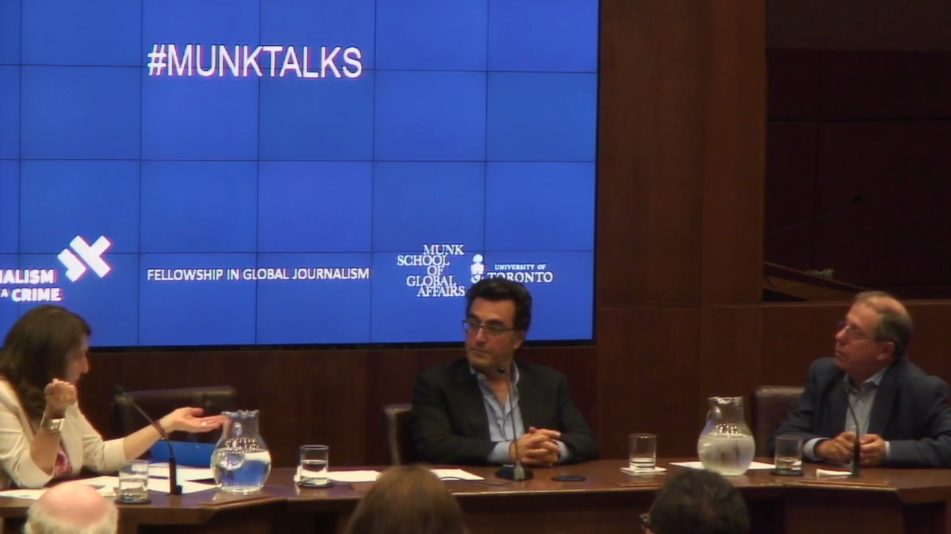News

A new landmark study on the well-being of Iranian journalists was launched on September 17 with a panel debate organized by Journalism Is Not A Crime at the Munk School of Global Affairs in Toronto.
Watch the full debate here.
”It was a bitter experience of being buried alive,” says Shahram Rafizadeh, an Iranian journalist who was arrested in Iran in 2004 and detained in a secret jail for 73 days. ”Now it has been ten years since it happened, but I am still unable to return to where I was before, from a psychological point of view.”
Rafizadeh appears in a short film screened before a full room of audience at Munk School of Global Affairs at the University of Toronto. In the film, four Iranian journalists tell their heartbreaking stories of being arrested, jailed and tortured; and how their past has deeply affected their life today.
But the four journalists are not alone: A new ground-breaking study for the first time shows the depth of the psychological impact of working as a journalist in Iran. The study, commissioned by Journalism Is Not A Crime, and carried out by University of Toronto professor Anthony Feinstein, found that high numbers of Iranian journalists have been subjected to threats, imprisonment, intimidation, and even torture. Consequently, many suffer depression and symptoms of post-traumatic stress disorder, PTSD, often making it impossible for them to do their work.
Launched on September 17 at the Munk School of Global Affairs, an expert panel discussed the report and the wider situation for Iranian journalists. The panel, moderated by CBC Radio host Anna Maria Tremonti, included founder of Journalism Is Not A Crime, Maziar Bahari, an Iranian-Canadian journalist whose 118-day imprisonment in Evin Prison was depicted in Jon Stewart's film Rosewater, and Anthony Feinstein, a neuro-psychiatrist, professor and world-leading expert on PTSD among journalists.
“It’s quite extraordinary what journalists in Iran will do because they believe in getting to the truth and telling people what’s going on, even though they put themselves in such peril,” said Anna Maria Tremonti, opening up the debate.
Elaborating on the study’s findings, Feinstein said he was surprised by the levels of threat the Iranian journalists has suffered:
“I did not anticipate this level of threat. I knew there was going to be some threat, but not at this degree,” he said. “Close to 20 percent of the journalists had been tortured. Almost 80 percent had to stop working on a particular story because they were too scared or traumatized to go on with their story. More than 50 percent reported that family members had been threatened or intimidated by the state. These are numbers I hadn’t encountered in 15 years of working with journalists.”
According to Bahari, these figures are not only staggering; they also represent a general problem in Iran.
“What is happening to Iranian journalists is emblematic of a larger problem in the society. If Anthony Feinstein carried out the same study on lawyers, artists, film makers, actors, accountants, dentists; they may be suffering the same,” he said.
Bahari: Support system is crucial
Having been imprisoned by the Iranian government for 118 days in 2009, Bahari’s story is similar to many of those of the 114 journalists who participated in the study. For him, a support system was invaluable to get through the time following his release.
“I was among the lucky ones,” he said, “because I had family outside of Iran, I had colleagues around the world, I had a good employer, Newsweek Magazine, that launched a campaign for me while I was in prison, and they provided me psychological help, medical help and legal help. But most of my friends are not that lucky. One of the reasons we did the study and launched the campaign Journalism Is Not A Crime is to help those other journalists who are not at lucky as I am.”
Among other issues related to the study, the panelists discussed why Iranian journalists in the diaspora suffer higher levels of PTSD symptoms and how citizen reporting has changed the field of journalism in Iran.
The main challenge now, Feinstein explained, is to help the journalists get access to treatment.
“On the plus side we know that what they suffer from is potentially treatable. There are good effective treatments out there for the kinds of emotional difficulties that we have defined,” he said.
By the end of the debate, Tremonti opened up for questions from the audience.
“How do you know what those red lines are?” one asked.
“The red line is something you grow up with,” Bahari said. “The government doesn’t tell you that you should not cover [for example] the Baha’i issue, you just know that the Baha’is are discriminated against. So it’s just common sense.”
However, the red line is often changing, making it even more insecure to work as a journalist in Iran. Bahari said:
“Sometimes criticizing something is not regarded as a red line, but the next day it is and it can result in your arrest, imprisonment and torture. This insecurity that is dominating the country is one of the most difficult issues to deal with.”
Watch the full debate here.
Related stories:
New Research: High Levels of Depression and PTSD Among Iranian Journalists
“Many of our patients are torture survivors from Iran”
"I was surprised by the high levels of stress among Iranian journalists" (part 1)
"According to my research 20 percent of Iranian journalists were tortured" (part 2)